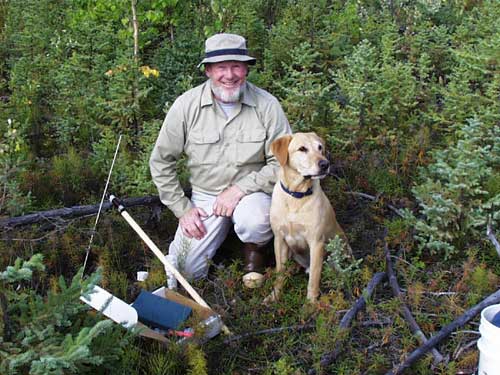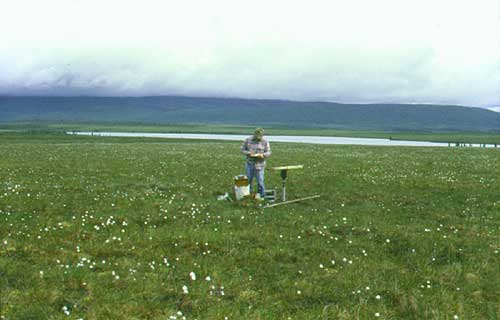 Pipeline bounty includes long-term
permafrost research
Pipeline bounty includes long-term
permafrost research
By Ned Rozell
January 31, 2008
Thursday
The trans-Alaska pipeline was a boon for welders, truck drivers
and thousands of others who in the '70s helped string the silver
tube across Alaska. A permafrost scientist also saw in the bonanza
a great opportunity for science.
Tom Osterkamp realized that a road traversing Alaska from north
to south (to enable building and maintaining the pipeline) would
allow a permafrost scientist easy access to the different types
of frozen ground in Alaska - the rock-hard soil hundreds of feet
thick on the North Slope, the thinner but still plentiful frozen
ground north of the Yukon River, the hit-and-miss permafrost
south of the Yukon, and the southernmost reaches of frozen ground
near Gulkana.

Tom Osterkamp with
his Labrador retriever Happy at a permafrost-monitoring site
near Bonanza Creek west of Fairbanks in 1999.
Photo courtesy Tom Osterkamp.
Osterkamp was a permafrost researcher with the Geophysical Institute
at the University of Alaska Fairbanks at the time of the pipeline's
construction. He received funding for a network of 100-to-200-feet-deep
holes in the soil from Prudhoe Bay southward. Osterkamp drilled
most of the 16 holes along that route in 1983. To that network
of "permafrost observatories," Osterkamp added others
over the years, the farthest south in Bethel. The holes, and
his dutiful years of driving across Alaska to see what they told
him, have given us a good snapshot of what Alaska's permafrost
has been doing for the last quarter century.
Permafrost, ground that has remained frozen for at least two
years, is a relic of a colder time that has endured in Alaska
and other northern places because summer's warmth still hasn't
overtaken winter's cold. As Alaska's air temperatures have warmed
in the recent past, Osterkamp and his colleagues have noticed
that the permafrost along the pipeline transect and elsewhere
in Alaska has responded.
Since 1976-1977, when Alaska climatologists noticed a "regime
shift," after which the state became warmer in most places,
Osterkamp captured some of the change on his network of boreholes.
Since he installed the observatories, permafrost temperatures
warmed from 3-4 degrees Celsius on the coastal plain of the North
Slope, increased 1-2 degrees Celsius in the Brooks Range, and
rose 0.3-1 degree Celsius south of the Yukon River in Interior
Alaska. The warming in the Interior has left much of the permafrost
here within one degree of thawing.
 Tom Osterkamp at a
permafrost-monitoring site near Healy in 1985.
Tom Osterkamp at a
permafrost-monitoring site near Healy in 1985.
Photo by Joan Osterkamp.
Though most of the permafrost in Alaska has gotten warmer during
the past quarter century, some have bucked the trend, and Osterkamp
is not sure why. Since he drilled boreholes at the Yukon River
Bridge and Livengood in the 1980s, permafrost there has gotten
colder. Since 1994, permafrost at an Eagle, Alaska borehole has
remained stable.
Warmer air is not the only thing that can thaw permafrost, Osterkamp
found. In Healy, off the now-famous Stampede Trail, permafrost
thawed even though air temperatures cooled. Increased snowcover
that traps the heat of the earth was the culprit, he said.
"Snow influences permafrost temperatures big-time,"
Osterkamp said. "Warming of the permafrost at Healy during
the late 1980s and 1990s was almost entirely due to snow cover
effects there. It also played a significant role in warming permafrost
along the pipeline."
These days, Osterkamp no longer drives the Dalton Highway and
stops at his boreholes. He retired from UAF in 1997, and now
lives in Saint Clair, Missouri. A few years back, he handed over
the monitoring of the boreholes to the Geophysical Institute's
Vladimir Romanovsky, who has expanded the program worldwide.
Now, a few decades since the word of a giant pipe across Alaska
inspired Osterkamp, he is sharing one of the most valuable resources
in science - the knowledge of a person who has studied something
for a long time.
Since his retirement, he has
traveled back to Alaska many times, written 25 papers (including
one due in April 2008 upon which I based this column), and three
book chapters.
"Joan (his wife) keeps asking me when I will really retire,"
he said.
This column is provided
as a public service by the Geophysical
Institute,
University of Alaska Fairbanks, in cooperation with the UAF
research
community. Ned Rozell [ nrozell@gi.alaska.edu
] is a science writer at the institute.
Note:
Ned Rozell is a speaker in
the 2008 Science for Alaska Lecture Series. You can meet the
writer Feb. 5 at 7 p.m. in the Westmark Gold Room in Fairbanks,
or Feb. 6 at 7 p.m. in UAA's Wendy Williamson Auditorium in Anchorage.
Go to http://www.sciencforalaska.com
for more information.
E-mail your news &
photos to editor@sitnews.us
Publish A Letter in SitNews Read Letters/Opinions
Contact the Editor
SitNews
©2008
Stories In The News
Ketchikan, Alaska
|


